MusicRadar Verdict
A significant number of enhancements mean you can control just about every aspect of the instrument’s majestic sound.
Pros
- +
Four layers of microphone capture, with onboard mixer.
- +
An amazing level of control.
- +
Enormously adaptable, both to your playing style and timbral output.
Cons
- -
There’s only one piano included, but you can substantially change its character.
MusicRadar's got your back
Synthogy Ivory 3 German D: What is it?
Back in the early-to-mid ’00s, sampling came of age. One of the companies at the forefront of the pursuit of multi-sampling perfection was Synthogy. Its original Ivory package was accompanied by rapturous applause from the professional and producer community, as it became an overnight industry standard.
Shuffle on 19 years and Ivory reaches its Mk3 phase, centred around an extensively sampled, Hamburg-manufactured, Steinway Model D-274.
Steinway is arguably the most highly regarded piano manufacturer in the world, with the Model D considered to be the finest concert grand. It’s certainly the largest, at 274cm in length, but with this size comes an authority in sound, which has established the brand as the primary choice for most concert halls.
It’s therefore hardly a surprise that Synthogy has chosen to capture this European Model D by reuniting members of its established sampling team, in the prestigious venue of Le Domaine Forget de Charlevoix Concert Hall.

Synthogy Ivory 3 German D: Performance and verdict
There are a considerable number of new features included in this sizeable upgrade. Firstly, Synthogy has a new sound engine called Real-time Gradient Blending (RGB).

• Modartt Pianoteq
This modelled plugin suite offers various package sizes and prices, according to your preferences.
• Native Instruments Definitive Piano Collection
This selection of three instruments provides a great collection of different piano timbres.
In layman’s terms, it’s an update to the real-time playback technology and DSP, taking the sound of the plugin to the next level. This translates to some impressive stats; Ivory 3 now responds to the MIDI 2.0 specification, although original MIDI controller users will still benefit from the usual 127 velocity points on the curve. This single piano will require 42GB of disk space, although Synthogy specify that this needs to be in SSD format, presumably because of the impacted speeds for reliable sample retrieval.
Extensive features have also been added in the areas of sustain resonance, on-board mixing and multiple configuration of stereo microphone, all captured in the concert hall environment. There is also significant control available, throughout the plugin; the number of options for change in tone colour, via many of the instrument’s components, means that while this piano undoubtedly has its own identity, it can be quickly and easily tweaked to yield the best results for the user.
Want all the hottest music and gear news, reviews, deals, features and more, direct to your inbox? Sign up here.
Given the number of captured samples, instrument loading is not the fastest, but it does reward from the moment you start to play. The definition and authority that you hear, as you play up and down the full range of the instrument, is quite extraordinary. There’s a slight unavoidable consequence, which translates as the bottom-end and lower-middle registers of the instrument sounding exceptionally strident. It does sound amazing, but these registers can sometimes overpower.
Ivory 3 includes a considerable number of presets, organised and curated by Synthogy, and scrolling through the various permutations delivers an impressive showcase. For transparency, we were employing some substantial full-range monitoring, which yielded significant bottom-end playback, which might also explain why we felt like we wanted to pull back the bottom end slightly, in favour of a clearer higher mid.

Mic placements and instrument settings
Ivory 3 provides the user with an abundance of setting controls. The most accessible of these are the mic channels, which relate to the onboard mixer. Each channel adopts its own set of samples, so there is a loading and RAM implication, as each channel set is engaged. However, the options are extensive, from close microphone placements, to mid/side arrangements and a more distant ambient signal. This could go a fair way to alter the sound that you require, but the menu-bound character settings allow for change in timbre, key noise and hammer strength, to name just a few. You can also change the resonant response, and the nature of the Soundboard.
Synthogy has additionally captured Una Corda samples, and you can even hear the identifiable Steinway sound of the dampers lifting from the strings, as you press the sustain pedal. There are also a number of additional sound sources, within the Synth section, which include a stunning set of acoustic String samples, supplied by AudioBros. If we said it was ‘comprehensive’, we would still be underselling the content.
Final recital
Diving into the substantial parameter menus, we found it easy to subtly change the signal, altering its makeup to an output which always hits the mark. While auditioning the plugin, across classical, jazz and more contemporary settings, Ivory 3 did continuously reward. We particularly enjoyed being able to move the lid to various positions, including fully closed, which resulted in some excellent pianistic colours. Pianos are very personal instruments, and we loved the ability to tame your piano to suit your desired 88-note perception.
Impressive on so many levels, we simply don’t have space or time to mention them all
When we first started playing with Ivory 3, the sound that we were hearing didn’t entirely resonate, and we have to question why? Out of the box, the tone is arguably darker and more tempered. Experiment with settings though, and you suddenly find a unique world of realism, which in piano terms makes this a Holy Grail. Ivory 3 is impressive on so many levels, we simply don’t have space or time to mention them all. But have no doubt, all of the colours are there, and it’s up to you to choose which of them best works for you.
MusicRadar verdict: A significant number of enhancements mean you can control just about every aspect of the instrument’s majestic sound.
Synthogy Ivory 3 German D: The web says
"All previous Ivory strengths are left intact, but are now combined with the best single piano capture Synthogy have ever offered, and about the most sophisticated velocity response of any sampled piano out there."
Sound On Sound
Synthogy Ivory 3 German D: Hands-on demos
SynthogyVIDEO
Simeon Amburgey
ILIO
Klinger Vocal Studio
Synthogy Ivory 3 German D: Specifications
- macOS 10.15 (Catalina) or newer. 16GB RAM minimum, 32GB RAM recommended.
- Windows 10 release 1609 or newer, 64-bit only. 16GB RAM minimum, 32GB RAM recommended.
- CONTACT: Synthogy
Roland Schmidt is a professional programmer, sound designer and producer, who has worked in collaboration with a number of successful production teams over the last 25 years. He can also be found delivering regular and key-note lectures on the use of hardware/software synthesisers and production, at various higher educational institutions throughout the UK

